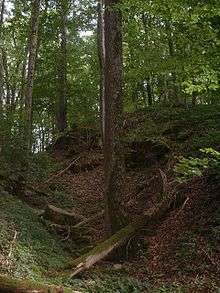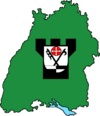Hertenstein Castle
Hertenstein Castle is a ruined spur castle approximately 900 metres (2,950 ft) southwest of the village of Billingsbach, part of the municipality of Blaufelden, in the district of Schwäbisch Hall in the state of Baden-Württemberg, Germany.
| Hertenstein Castle | |
|---|---|
| Blaufelden-Billingsbach | |
 Remains of the keep | |
 Hertenstein Castle | |
| Coordinates | 49.297879°N 9.888543°E |
| Type | Spur castle |
| Code | DE-BW |
| Height | 442.8 m above sea level (NN) |
| Site information | |
| Condition | Ruin |
| Site history | |
| Built | Early 13th century |
| Materials | Buckel stone |
| Garrison information | |
| Occupants | Ministerialis |


Description
The castle is located on a steep hill above the confluence of two streams (the Billingsbach and the Rötelbach) at an elevation of 442 metres (1452 ft). The main approach of the castle to the northeast was protected by an 80-metre (262 ft) long artificial moat running from the steep slopes to the north towards the neighbouring hill in the south. The moat is between 5 and 6 metres (16 and 19 ft) deep. Out of the moat a mound rises which are the remains of the outer ward, followed by a drop of 3 to 4 metres (10 to 13 ft) towards the inner ward. Inside the inner ward is a flat triangular area about 32 metres (105 ft) long and 25 metres (82 ft) wide, in the middle of which the remains of the bergfried (keep) are found. All that is left of the keep is a mound rising up to 5 metres (15 ft) with a diameter of 8 metres (26 ft). The keep was built of rustication buckel stones (squared-off stones with a rounded outer surface).[1]
Only the moat is clearly visible today as none of the castle's structures above ground have survived. The whole area is covered by dense woodland.
History
The castle was built in the early 13th century. The original builders and owners of the castle are unknown. The existence of a castle is only documented as late as 1314 when a certain Eberhard von Hertenstein, lord of Billingsbach and vassal of the counts of Hohenlohe, appeared as a witness in a charter. The lords of Billingsbach seemed to have moved to the spur castle at the beginning of the 14th century.[2] Yet, towards the end of the 14th century, after the extinction of the House of Billingsbach and the castle's return to the counts of Hohenlohe in 1370, the castle appeared to have lost its function as a dwelling place for the local nobility.[3] On a map from 1578, the castle is indicated as being in a ruinous state.[4]
Function
A trading route leading from Künzelsau through the valley of the Jagst towards Schrozberg and Rothenburg ob der Tauber passed through Billingsbach, where it crossed two streams. One of the functions of Hertenstein Castle was to guard this crossing and to protect travellers.[5]
Excavation
In 1948 and 1950, excavations on a small scale revealed shards of ceramics and other artefacts[6] from the medieval period as well as the 16th century, indicating that the castle was inhabited at least until the early modern period.[7]
See also
References
- A. Schneider, Die Burgen im Kreis Schwäbisch Hall, p. 28
- A. Schneider, Die Burgen im Kreis Schwäbisch Hall, p. 28
- Statistisches Landesamt Württemberg (ed.), Das Königreich Württemberg, p. 182
- K. Schumm,"Landkarten als Quellenmaterial", p. 129
- A. Schneider, Die Burgen im Kreis Schwäbisch Hall, p. 30
- U. Lobbedey, Untersuchungen mittelalterlicher Keramik, p. 61
- A. Schneider, Die Burgen im Kreis Schwäbisch Hall, p. 28f.
Further reading
- Königlich Statistisch-Topographisches Bureau (Württemberg) (ed.) (1847). Beschreibung des Oberamts Gerabronn. Stuttgart - Tübingen: Cotta.CS1 maint: extra text: authors list (link) (in German)
- Lobbedey, Uwe (1968). Untersuchungen mittelalterlicher Keramik, vornehmlich aus Südwestdeutschland. Berlin: de Gruyter. (in German)
- Schneider, Alois (1995). Die Burgen im Kreis Schwäbisch Hall. Eine Bestandsaufnahme. Stuttgart: Theiss. ISBN 3-8062-1228-7. (in German)
- Schumm, Karl (1952), "Landkarten als Quellenmaterial", Schwäbische Heimat (in German), 3: 128–140
- Statistisches Landesamt Württemberg (ed.) (1906). Das Königreich Württemberg. Eine Beschreibung nach Kreisen, Oberämtern und Gemeinden. Teil 3: Jagstkreis. Stuttgart: Kohlhammer.CS1 maint: extra text: authors list (link) (in German)
